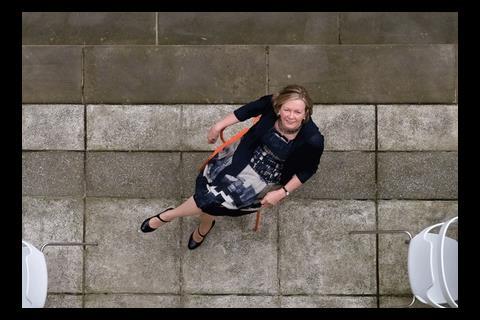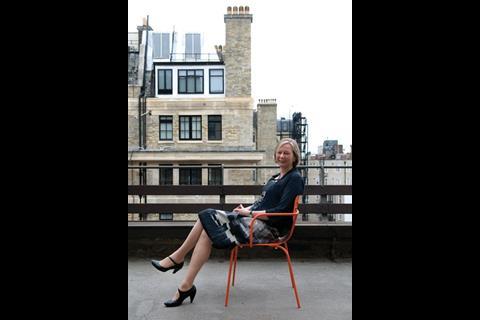Ruth Reed wants to change peopleâs views of the RIBA â and becoming the instituteâs first woman president isnât a bad place to start. She talks to Dan Stewart about her priorities for her two-year stint, the recession and how she hopes to make the RIBA less London-centric
The average age of a RIBA member is 52. Ruth Reed, the bodyâs incoming president, who turned 52 this year, puts her hands to her mouth and laughs when she hears this. âThat was a set-up, wasnât it?â she says. âBut itâs okay because Iâm not your average member of the RIBA.â
Sheâs not wrong there. First and foremost, being female means she is the same sex as 15% of her profession. And there canât be many architects who have worked for a local authority, a housebuilder, a large practice and as a sole practitioner. If all of this werenât enough, last September Reed entered a class of one when she was elected the RIBAâs first female president.
Since then she has been quietly preparing for her two-year term, thinking about the areas she wants to focus on when she takes over from Sunand Prasad in September. After months of keeping her plans for the job more or less under wraps, she is now ready to talk about what the architectural world can expect from its first helmswoman. âThereâs 12 months of sitting quietly in the back room, because itâs not appropriate for the president-elect to speak up,â she says. âWell, Iâm looking forward to being able to speak up now.â
Outside RIBA council circles, Reed is something of an unknown quantity. And she has a lot to prove as she prepares to sacrifice her relative anonymity for the role of president: âPolitically, sheâs very experienced but sheâs not so hot on design or culture or young stuff,â says one council member who wished to remain unnamed. âThe impression is of a homespun architect who hails from the provinces. Itâll be interesting to see how she fares in the bright lights of London.â
In fact, Reed was elected on a platform of giving a greater voice to the regions, with an emphasis on reforming planning and architectsâ fees, but she says the downturn will be the first thing to tackle when she becomes president. âIn a recession, the RIBA needs to be very clear about what itâs doing for the membership,â she says. This includes initiatives such as the ârecession survival toolkitâ (a pack giving advice to members, accompanied by a series of seminars across the country) and lobbying the government on public sector spending.
She adds that of all the issues facing architects in the recession, the worst is that they are expected to work for a ridiculously low fee in order to maintain turnover and relationships with clients. âItâs horrifying, and the worst of it is it takes so long to change,â she says. âWe were underselling ourselves for a long time after the nineties.â
What else can the RIBA do to help architects? Reed says providing information and resources is the main thing to focus on. But what about leadership? âOf course. There needs to be a high level of advocacy at government level,â she says, adding that she is ready for the challenge. âI know a bit about politics, and how ministers work. Itâs all about personal contact. I feel confident at that level.â
A lot of architects say there isnât enough long-term leadership coming from the RIBA itself. The presidentâs term is only two years. Is it up to the executive to provide a clearer, long-term message for architecture? âI donât think so,â she says. âI think what the profession wants from us is a clear agenda on quality, and the ways to achieve that. I donât think people expect the RIBA to do anything else.â
Only the first stage
When it comes to her clear agenda, Reed accepts that some of her manifesto pledges have been scuppered by the recession. But she is confident that her two-year term will give her plenty of time to achieve her main ambitions. âIt sounds like a negative thing to be looking to do â to cope rather than to achieve â but thatâs only the first stage,â she says. One of her first priorities in September will be to do a tour of the regions to canvass the membership on the recession, and ask what they want her to do as president. âI donât want just to go through the committee structures, important as they are, but to visit schools and small practices in places like north-west England and Hull,â she says.
âI know this sounds like politician-speak, but there is an enormous value in listening to people. How can you give people a voice if youâre not listening?â
An important part of the Reed presidency will be building a solid relationship between architectural schools and the RIBA. Her plan is to create a network of schools, not only to improve the RIBAâs educational services for younger architects, but also to engage architects with their institute from the beginning of their careers.
When a woman steps into any role for the first time they have a lot to prove. I donât think there will be any exception here
She worries that the London-centric nature of the RIBA risks provoking a âdisenchantmentâ between architects and their professional body. âThere is a lack of feeling of ownership of the institute,â she says. âThe members are the RIBA, and that is its strength. Thatâs got lost in translation somewhere.â
One thing the body certainly hasnât lost in recent weeks is a public presence. As șĂÉ«ÏÈÉúTV went to press, the debate over the design of the Chelsea Barracks scheme was at boiling point, complete with fevered media rumours that the steel and glass design by Rogers Stirk Harbour + Partners was about to be dropped. The controversy began in April when Prince Charles intervened to back a traditional alternative by Quinlan Terry. Reedâs position on this is clear. âI donât approve of attempts to influence what should be a democratic process,â she says. âItâs become a rallying point for the opponents of that scheme and I think thatâs wrong. There should be a level playing field, but nobodyâs going to be happy with this one. Itâs gone too far on both sides.â
Reed herself is unwilling to be drawn into the âstyle warâ argument. âIâm about to be president of a very broad church, and our members design across the spectrum. Itâs about excellence of design, not what the wrapping paper looks like.â
Gentlemenâs club?
Irena Bauman, a Cabe commissioner, recently wrote a scabrous column in an architectural magazine describing the RIBA as a âgentlemenâs clubâ. Reed is dismissive of Baumanâs piece, describing it as âa rather hackneyed and prejudiced vision of the RIBA, playing on a few emotive stereotypesâ. But doesnât the description of the body as a wood-panelled club populated by elderly men not ring any bells?
âNot really,â she says, bluntly, showing a flash of impatience behind the polite smile. âLook, the real concern is the number of talented young women who are choosing to leave the profession. If you look at our make-up, then of course there is going to be a high percentage of men. At many branch meetings Iâve been the only woman in the room. But I enjoy changing peopleâs views of the RIBA. I wouldnât be here otherwise.â
Reed would like to be seen as a role model for young female architects, something else she aims to achieve through her work as president. But she admits that life as a female architect has not always been easy: âI had a private practice to facilitate childcare, and I was the primary parent in terms of childcare, so it has affected my career. But thatâs why itâs important to say how adaptable the profession is. As a woman, you can make architecture work for you.â
Reed may not buy in to the gentlemenâs club theory but she does concede that she expects to have to work harder to be taken seriously because of her gender. âWhen a woman steps into any role for the first time they have a lot to prove,â she says. âI donât think there will be any exception here.
âItâs important to be robust. At first if women didnât go along with sexism, they were accused of not having a sense of humour. Now, the person being sexist is the one exposing themselves to ridicule. Thatâs how far weâve come.â
Team player
Reed is clear about the sort of president she wants to be. She says she is happy with the public attention â âWhy would you stand for the president of the RIBA if you didnât want to be the public face of the institute?â â but reveals she will take a different approach to past presidents. âI donât want you to read into this any criticism of the previous president, because I have the utmost respect for Sunand and what he has done, but I think Iâm more of a team player,â she says. âI donât want the only face of the RIBA to be Ruth Reed. I donât think that would say the right thing about me, and I donât think it would say the right thing about the institute.
âWhatever happens during my presidency, they certainly wonât forget me.â
Postscript
Original print headline: 'Reed out loud'.





























1 Readers' comment